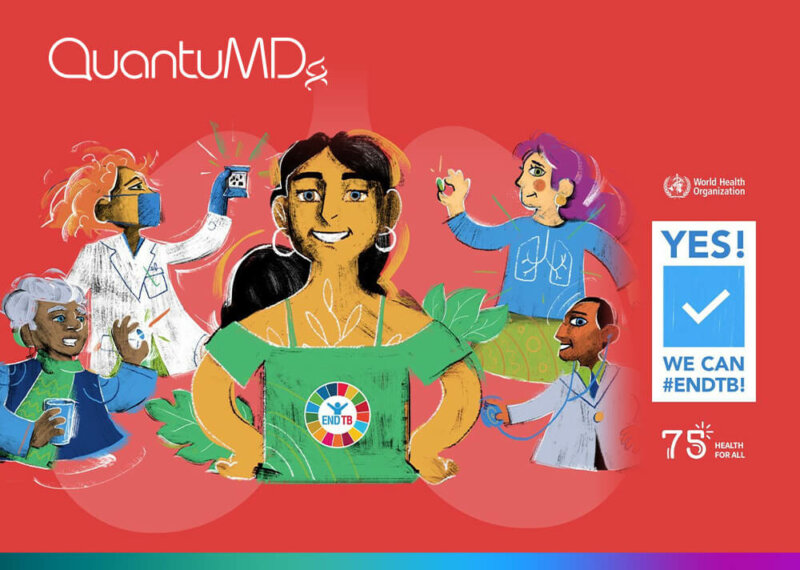Friday 24 March 2023 is World Tuberculosis Day. Coinciding with the date in 1882 when Robert Koch first described his work isolating the bacterial cause of tuberculosis, March 24 is a day dedicated to raising awareness of TB, in particular the collaborative need to accelerate global efforts to end TB.
This short post describes why TB remains a challenge and how a novel diagnostic approach could drive the disease towards eradication.
Challenge #1: the global TB burden
Tuberculosis (TB) is an infectious disease caused by Mycobacterium tuberculosis.
About one quarter (2 billion) of the world’s population are infected with M. tuberculosis (WHO Factsheet) , in its latent form. Worldwide in 2021,
- 10.6 million people became ill with TB, including 1.2 million children
- 60% cases (6.4/10.6 million) were detected and notified
- 1.5 million people died from TB
- 30 low- and middle- income countries (LMICs) are described as having a high TB burden and account for 87% new TB cases (WHO Factsheet).
TB treatment is arduous, typically requiring a combination of four antimicrobial drugs (commonly isoniazid, rifampin, pyrazinamide and ethambutol) for six to 12 months.
M. tuberculosis can develop resistance to these antimicrobial drugs, meaning that the infection no longer responds to treatment and remaining treatment options are less effective.
Challenge #2: the TB continuum
TB represents a spectrum of disease.
Person-to-person transmission occurs via inhalation of respiratory droplets containing M. tuberculosis. The most common location of infection is the lungs (pulmonary TB); however, the bacteria can spread from the lungs and cause infections at other sites (extrapulmonary TB).
Not everyone exposed to M. tuberculosis will become ill. In most healthy people, the immune system will either eliminate the infection or sufficiently limit the growth and multiplication of the bacteria in the lungs. In this state, known as latent TB, the individual will be asymptomatic and will not be infectious to others. If the infection is not controlled or contained by the immune system, active TB disease may occur.
In 2019, global prevalence of latent TB infection (LTBI) was around 25% (Cohen et al., 2019). In 5-10% of cases, reactivation of M. tuberculosis may lead to development of a subclinical infection and progression to active disease, depending on the immune status of the individual. Detection and treatment of individuals with LTBI can reduce progression to active disease and associated onward transmission of M. tuberculosis.
However, this can lead to huge overtreatment of patients whose latent infections will never progress to the active form of the disease. Therefore, it is important to identify the patients whose disease has started to convert from latent to active disease, a stage that is called subclinical or incipient TB, and differentiate these from those patients who just have latent disease. The subclinical stage usually last for 18 months prior to the onset of symptoms (night sweats and coughing, which is how the disease is transmitted). Prophylactically treating patients in this stage (and not over treating people with latent TB) will halt the chain of transmission, helping public health efforts to reduce the TB burden in populations.
Challenge #3: available diagnostics
The basis of diagnosis of active pulmonary TB relies largely on observing changes in lung morphology (usually by chest X-ray) or microbiological investigation of sputum specimens for M. tuberculosis (using microscopy, bacterial culture, or molecular detection of DNA).
Although very slow (typically >28 days), bacterial culture remains the diagnostic gold standard for active TB, enabling mycobacterial identification, drug susceptibility testing, and genotyping for the purposes of contact tracing (CDC).
In contrast, there is no gold standard method for diagnosis of LTBI, which currently relies on detection of an immune response to exposure to M. tuberculosis. Two methods are the mainstay of LTBI diagnosis: the tuberculin skin test (TST) and gamma interferon (IFN-γ) release assays (IGRA); however, “neither can accurately differentiate between LTBI and active TB, distinguish reactivation from reinfection, or resolve the various stages within the spectrum of M. tuberculosis infection” (Pai et al., 2014).
A novel diagnostic approach
There is an urgent unmet clinical need for rapid, accurate non-sputum-based TB testing directly at the point-of-need (i.e. at the location of the patient).
Diagnostic tests using a fingerstick blood sample (small volume and easy to obtain) could improve diagnosis of TB, particularly if the tests were able to differentiate between active TB and LTBI.
Novel diagnostics that harness the power of transcriptomic technology are being explored as an alternative to traditional diagnostic methods. This new approach enables the dynamic detection and measurement of levels of expression of messenger RNA (mRNA) and offers advantages over the static detection of the presence or absence of genes.
RISK6 is one example of a transcriptome-based diagnostic currently in development. The relative ct values and ratios of six mRNA transcripts are applied to an algorithm that generates a ‘TB Host Immune Response Score’. The score is used to predict the risk of TB disease and treatment response.
In a multi-national evaluation, RISK6 successfully differentiated between individuals with active TB from healthy controls with high sensitivity (91%) and specificity (88%), achieving the minimal WHO target product profile for a non-sputum-based TB screening test (Bayaa et al., 2021).
A further benefit to this diagnostic approach is that patients can be tested throughout their treatment to ensure the treatment is working, or to detect, early, treatment failure.
World TB Day 2030?
By 2030, the WHO aims to reduce the number of new cases of TB by 80% (WHO End TB Strategy).
Our mission at QuantuMDx is to make transformative multiplex diagnostic solutions accessible to everyone, so that diseases can be detected and treated earlier.
Together with our collaborators, we are striving towards the eradication of TB by developing innovative yet affordable TB testing suitable for deployment in any healthcare setting across the globe.
With continued investment and support for the translation of novel diagnostics into clinical practice, we are confident that on World TB Day 2030, the world will be nearer to achieving eradication of this devastating disease.
We have also released a new publication exploring A Novel Microfluidic Dielectrophoresis Technology to Enable Rapid Diagnosis of Mycobacteria tuberculosis in Clinical Samples for consideration of technology surrounding TB, an insightful publication on Microfluidic Capture of Mycobacterium tuberculosis from Clinical Samples for Culture-Free Whole-Genome Sequencing and a publication detailing the use of CAPTURE-XT®, a rapid pathogen concentration and sample clean-up technology, as a front-end for Next-Generation Sequencing of Mycobacterium tuberculosis from clinical sputum samples.








